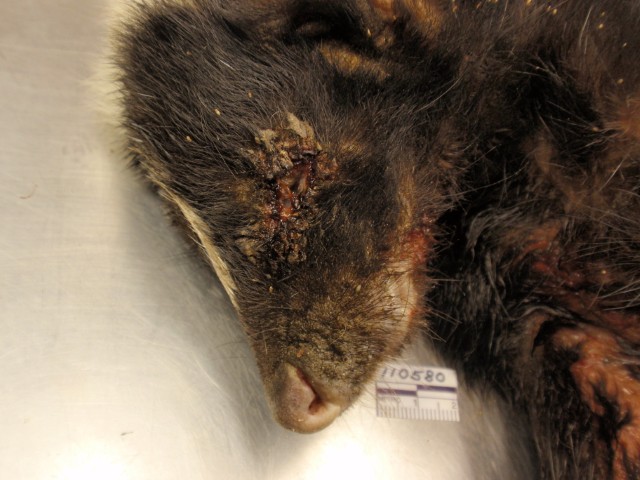Canine Distemper is a highly contagious disease caused by a paramyxovirus. It is a widespread disease affecting wild and domestic carnivores and this primarily affects raccoons, grey fox and skunks in the spring and fall.
Clinical signs begin 10-14 days after infection and include discharge from the eyes and nose, dyspnea (difficulty breathing), coughing, and pneumonia. Fever, anorexia and respiratory tract issues are most common.
Canine distemper virus (CDV) also causes gastrointestinal illness, thickening of the nose and foot pads, and a neurologic phase that has symptoms similar to rabies and can be difficult to distinguish as a result.
Transmission occurs from contact with infected saliva, urine, feces or respiratory secretions. Animals can shed up to 2 weeks after they recover. The virus can survive long periods in the environment if the temperatures are below freezing.
Canine distemper can be diagnosed with nasal or ocular swabs or from tissue samples such as foot pads, bladder or lung.
There is no cure, only supportive care, so preventative measures to reduce the risk of spreading the virus is key. This virus is nearly 100% fatal for mustelids.
The disease is found in canids (domestic dogs, coyotes, wolves, foxes) as well as raccoons, javelinas, and some marine mammals. Mustelids (black footed ferrets, mink, and skunks) are especially susceptible to the disease. One case has been reported in a black bear and cases have been reported in monkeys. It can cause high mortality in large exotic cats (tigers and lions).
The virus is transmitted by inhalation of aerosolized particles and direct contact. It is shed in the urine, feces, and secretions of infected animals. The virus is resistant to cold and the majority of cases in domestic dogs occur in the fall and winter. The disease is often fatal with a mortality rate of 50% in adult dogs and 80% in puppies. Increased susceptibility to distemper in juveniles results in more wildlife cases in the spring and summer when babies are being born. However, there are cases year round. The mortality rate is close to 100% in mustelids.
The virus causes respiratory issues and fever. It also causes gastrointestinal illness including vomiting and diarrhea, as well as thickened skin on the nose and footpads (hyperkeratosis).
The neurologic phase of the disease affects the central nervous system and can cause disorientation and weakness along with progressive seizures. The “chewing gum fit” is the classic distemper sign that begins with snapping and jaw spasms that progress to seizures. Wild animals with late neurologic stage distemper have can exhibit fearlessness, aimless wandering, and aggressiveness.
The treatment for canine distemper is supportive care as there is no cure. Therefore, prevention is important in preventing mortality from CDV. Preventative measures include vaccination of domestic species, removal of infected carcasses, and decontamination of areas where infected animals were treated.
CDV is not transmissible to humans.




